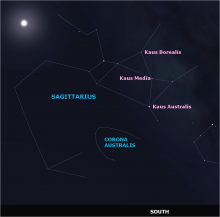Listen to today's episode of StarDate on the web the same day it airs in high-quality streaming audio without any extra ads or announcements. Choose a $8 one-month pass, or listen every day for a year for just $30.
You are here
Perseus
In mythology, Perseus was a hero. Today, we might give him a more dramatic title: monster killer. He dispatched not one, but two nasty creatures. As a result, he’s commemorated in the stars. His constellation is in the northeast at nightfall, above the bright star Capella.
Perseus was the son of Zeus, the king of the gods of Olympus, and a mortal woman. Polydectes, the king of Perseus’s home island, sent him to kill Medusa, one of the Gorgons — sisters with writhing snakes on their heads. One look at them turned the viewer to stone.
Perseus chopped off Medusa’s head. He then killed Cetus, a sea monster who’d been sent to ravage Ethiopia. Finally, Perseus used Medusa’s head to turn the king and his cronies to stone after they’d mistreated his mother. When Perseus died, Zeus placed him in the heavens.
The hero’s brightest star is Mirfak, a name that means “elbow.” It’s directly above Capella in early evening. It’s more than 500 light-years away. It’s more than 60 times the Sun’s diameter, and 5,000 times its brightness.
Mirfak is about 40 million years old — a mere infant. Yet its life is almost over. It’s about eight times the Sun’s mass. Such heavy stars burn out quickly. As Mirfak dies, it might expel its outer layers, leaving only a heavy white dwarf. On the other hand, it might blast itself to bits as a supernova, leaving a super-dense corpse known as a neutron star.
Script by Damond Benningfield



